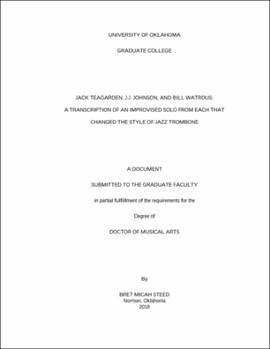| dc.description.abstract | When discussing the art and history of jazz trombone improvisation, three names are invariably mentioned as being among the top of the heap: Jack Teagarden, J.J. Johnson, and Bill Watrous. According to Kurt Dietrich, Johnson and Teagarden are easily the most celebrated trombonists within the history of jazz. Later in his book, Dietrich also mentions that Watrous became the most prominent “new jazz trombonist” beginning in the 1970-’s and throughout much of the 1980-’s and 1990-’s as well. The primary argument, as presented within this document, is that these three men ultimately changed the course of jazz trombone style within their respective time periods more so than any of their contemporaries for a number of harmonic, stylistic, and technical reasons. As I discuss later in detail, each man’s debut recording was drastically different from recordings made by other trombonists during his particular time period. In effect, a “passing of the torch” took place because of their debut recordings. These recordings marked new and innovative styles that the next generation of jazz trombonists would emulate.
Delineated into three sections, the bulk of this document focuses on the analysis of solo transcriptions taken first from the debut recordings of Teagarden; (1928) Johnson; (1946) and Watrous (1974). Detailed analysis is also provided for solo transcriptions of three prominent trombonist within the realm of jazz during the same time periods prior to Teagarden’s, Johnson’s, and Watrous’ debut recordings: Miff Mole; (1928) Bill Harris; (1945) and Urbie Green (1968). Each analysis includes an in- depth look at each solo from harmonic, technical, and stylistic points of view.
This study also offers important and historical insights into how the public reacted upon hearing Teagarden, Johnson, and Watrous for the first time. At the end of each section, a conclusion is drawn detailing why Teagarden’s, Johnson’s, and Watrous’ debut solos were able to captivate audiences and in effect, how they transformed the course of jazz trombone style. | en_US |
